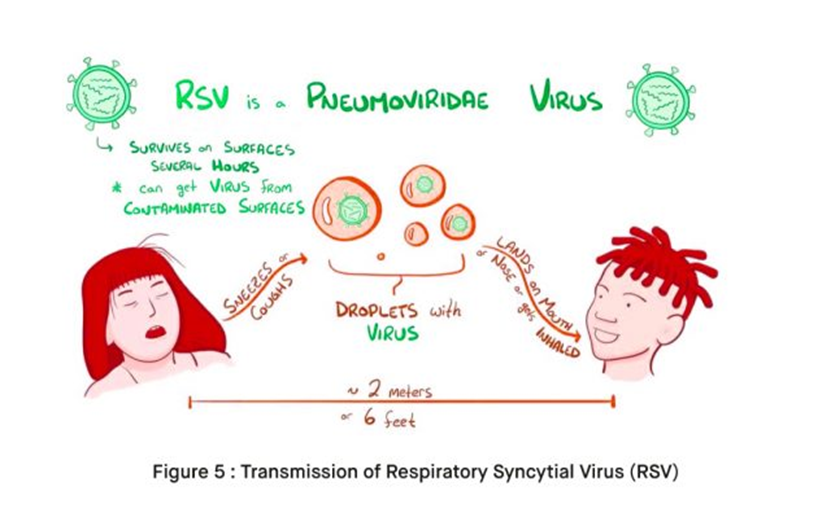A nurse is assisting with the admission of an infant who has respiratory syncytial virus (RSV), which of the following rooms should the nurse assign the infant?
A room with a toddler who has pneumonia
A private room with reverse isolation
A private room with contact/droplet precautions
A room with an infant who has croup
The Correct Answer is C
A. A room with a toddler who has pneumonia.
This option is not ideal because both RSV and pneumonia are respiratory infections that can spread to other patients. Placing these two patients together could increase the risk of cross-infection.
B. A private room with reverse isolation.
Reverse isolation is typically used to protect immunocompromised patients from acquiring infections from others. However, in the case of RSV, reverse isolation is not necessary because RSV primarily affects infants and young children who are generally not immunocompromised. Therefore, this option is not appropriate for an infant with RSV.
C. A private room with contact/droplet precautions.
This option is the most appropriate. RSV is primarily spread through respiratory droplets and direct contact with respiratory secretions. Placing the infant in a private room with contact/droplet precautions helps to minimize the risk of transmission to other patients. Healthcare workers and visitors entering the room should adhere to appropriate precautions, including wearing personal protective equipment (PPE) such as masks, gloves, and gowns.
D. A room with an infant who has croup.
Placing an infant with RSV in the same room as an infant with croup is not ideal because both conditions involve respiratory symptoms and may increase the risk of cross-infection.

Nursing Test Bank
Naxlex Comprehensive Predictor Exams
Related Questions
Correct Answer is B
Explanation
A. Pulmonary function test:
Pulmonary function tests (PFTs) assess lung function by measuring airflow, lung volume, and gas exchange. While PFTs can provide valuable information about respiratory function, they are not specific to cystic fibrosis and may show abnormalities consistent with various respiratory conditions. However, PFTs are often performed in individuals with cystic fibrosis to monitor lung function over time and assess response to treatment. They are not considered the most definitive test for diagnosing cystic fibrosis.
B. Sweat chloride test:
This option is correct. The sweat chloride test is considered the most definitive diagnostic test for cystic fibrosis. It measures the concentration of chloride in sweat, which is typically elevated in individuals with cystic fibrosis due to defective chloride transport in sweat glands. A sweat chloride concentration above a certain threshold (usually ≥60 mmol/L) is diagnostic of cystic fibrosis, particularly when confirmed with repeat testing.
C. Stool fat content analysis:
Stool fat content analysis evaluates fat absorption and fecal fat excretion, which may be impaired in individuals with cystic fibrosis due to pancreatic insufficiency. However, while stool fat content analysis can provide supportive evidence of malabsorption in cystic fibrosis, it is not considered the most definitive test for diagnosing the condition. Stool fat content analysis is often used in conjunction with other diagnostic tests to assess pancreatic function and nutritional status in individuals with cystic fibrosis.
D. Sputum culture:
Sputum culture involves culturing respiratory secretions to identify bacterial pathogens, which can be useful for diagnosing respiratory infections in individuals with cystic fibrosis. However, sputum culture is not specific to cystic fibrosis and may show similar findings in other respiratory conditions. While respiratory cultures are important for guiding treatment in cystic fibrosis, they are not considered the most definitive test for diagnosing the condition.
Correct Answer is B
Explanation
A. "I will elevate the affected area if possible."
This statement is correct. Elevating the affected area can help reduce swelling and minimize bleeding by promoting venous return. Elevating the limb above the level of the heart can aid in controlling bleeding and is a recommended intervention.
B. "I will apply warm compresses over the site."
This statement is incorrect. Applying warm compresses is generally not recommended for controlling bleeding in hemophilia. Heat can increase blood flow to the area, potentially exacerbating bleeding. Cold compresses or ice packs are typically recommended to help constrict blood vessels and reduce bleeding.
C. "I will have my child rest."
This statement is correct. Resting is an essential component of managing bleeding episodes in children with hemophilia. Physical activity and exertion can increase the risk of injury and bleeding, so it's important for children with hemophilia to avoid strenuous activities during bleeding episodes.
D. "I will promptly mobilize the involved area to relieve pain & decrease bleeding."
Immobilizing the affected area can help control bleeding and reduce pain by minimizing movement. This is also an appropriate response.
Whether you are a student looking to ace your exams or a practicing nurse seeking to enhance your expertise , our nursing education contents will empower you with the confidence and competence to make a difference in the lives of patients and become a respected leader in the healthcare field.
Visit Naxlex, invest in your future and unlock endless possibilities with our unparalleled nursing education contents today
Report Wrong Answer on the Current Question
Do you disagree with the answer? If yes, what is your expected answer? Explain.
Kindly be descriptive with the issue you are facing.
